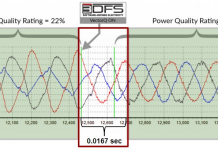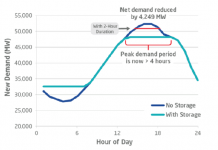By Harris Roen
The modernization of the electric grid is an exciting investment opportunity that promises to be one of the biggest energy investment stories of the early 21st century. Smart Grid systems will provide large growth opportunities for many companies around the globe. This is being accomplished through a combination of updating existing technologies along with the creation of new systems aimed at improving the quality of the electric grid.
By understanding how the dream of a smart grid will become a reality, an informed investor will be in a very good position to capitalize on this trend. Accordingly, this report outlines what the smart grid is, what it can do, and most importantly, which companies are most likely to profit from smart grid business.
WHAT IS THE SMART GRID?
According to the U.S. Department of Energy, creating a smart grid is a “colossal task” that will take years or even decades to complete. Because this undertaking is so enormous, and because we are only in the early stages of smart grid implementation, the term “smart grid” defines more of a goal than a specific design or outcome.
Smart Grid technology is defined as having the following characteristics:
- Enables active participation by consumers in demand response
- Self-heals from power disturbance events
- Operates resiliently against physical and cyber attack
- Provides power quality for 21st century needs
- Accommodates all generation and storage options
- Enables new products, services, and markets
- Optimizes assets and operates efficiently
The smart grid, therefore, pertains to any part of the electric infrastructure, from the power plant to transmission lines to the end user, which can make the system work more efficiently through improved communication and integration.

The chart above is a simplified diagram showing how energy and information moves through the smart grid. Energy and information are represented by blue arrows that can move in two different directions.
WHAT CAN A SMART GRID DO?
Currently the grid is all about providing enough electricity during peak usage times so the system will not fail. That means that there is plenty of excess capacity during non-peak periods.
One example of how a smart grid could improve this reality is in conjunction with electric vehicles. Vehicle battery systems could be set to charge at night, when peak demand is low and there is plenty of capacity. Cars that are parked during the day could then feed power back into the grid when electricity demand is higher.
This is but one of the many ways that a smart grid could act synergistically in reducing energy use and promote alternative fuel sources. Some other promises of a fully functioning smart grid include:
A city of buildings that will make slight adjustments to heating or air conditioning when peak demands become critical.
A dishwasher that will know to turn itself on when power demand is at its least.
A utility that will know in real time how to most efficiently use their substations to save on distribution costs and loads.
All this and much more are benefits that a smart grid can bring to the nations power system. When these types of energy savings are combined with maximizing the particular generating characteristics of alternative energy producers such as wind and solar, there is a synergistic benefit of reducing carbon emissions and other pollutants.
INGREDIENTS THAT FORM THE SMART GRID
Some smart grid technologies are already in use, or are close on the horizon. Many of the ingredients or components that will create the smart grid, however, are farther away as smart grid vendors compete through a myriad of implementation standards and strategies.
To get a handle on what a smart grid means for different industries, it is useful to break down the components of smart grid technologies.
Advanced metering
A typical electric meter merely records the amount of electricity being used. Advanced metering can send information in more than one direction, which will create a mountain of data that will be useful to both electric providers and end users. Businesses in this area are meter manufacturers, communications companies, and data management systems.
Demand Response
Demand response has the goal of identifying peak electric usage times, and finding ways to curtail that use. This has already been going on for decades; utilities may simply get on the phone with major energy users to work on peak time reduction strategies through price incentives or other measures. Also, utilities have implemented outreach programs to home owners and other users. If demand response was updated and automated, it could drastically change the electric grid landscape.
This could well be the most important energy and cost saving component of the smart grid, resulting in a 20% reduction of peak energy use in less than 10 years. Demand response efforts will start with large industrial and commercial users in the short term, and will eventually reach into individual households via smart appliances.
Distribution Grid Management
This effort is focused on improving the inelegance of the electric grid: sub-stations and electric lines. According to Cleantech “Smart meters and home energy management systems may be easier to grasp and may appear more tangible than distribution system concepts such as Volt/VAR control and feeder automation, but improvements in core distribution technology can have tremendous impacts on efficiency.”
Electric companies could see a quick payoff by installing routers, switches, data recorders and that like on thousands of sub-stations, which could have an immediate impact on millions of miles of electric wire, creating substantial business for vendors in this area. Integrating these complex, multi-platform systems will also be a substantial continuing business for service providers.
Home energy management
Systems that integrate a home’s energy usage into a so called “smart home”. This could include a myriad of sensors and communications systems between appliances, outlets, thermostats, consumer devices, security systems and the like. Though initial costs are high, if done in aggregate across millions of homes the energy savings could be substantial.
Building energy management
Deploying smart systems to office buildings, factories, apartments and the like can have a much more immediate impact than home energy management. Most of the savings will come with more intelligent lighting and HVAC (Heating, Ventilating, and Air Conditioning).
These systems will also employ the need for sensors and communication equipment, net-worked together in a centralized monitoring and control apparatus.
Interconnection of the Grid
Defines how different power sources, e.g. wind turbines, solar arrays, conventional power plants, will connect to the electric grid. Solar is particularly different in that it produces power in Direct Current (DC), as opposed to the more common Alternating Current (AC).
The issues of grid interconnection are laid out in detail in the United Nations report Multi Dimensional Issues in International Electric Power Grid Interconnections. The benefi
ts of improved grid interactions range from preventing blackouts to better interfacing with electric vehicles. And the potential cost savings could go into the billions of dollars.
This is the first part of a three-part series drawn from “Smart Grid Investment Opportunities: Understanding the Smart Grid Investment Landscape” is a special supplement to the “ROEN FINANCIAL REPORT” ISSN 1947-8364 (print) ISSN 1947-8372 (online), published monthly for $69 per year print or $59 per year e-mail by Swiftwood Press LLC, 82 Church Street, Suite 303, Burlington, VT 05401. © Copyright 2010 Swiftwood Press LLC. All rights reserved; reprinting by permission only. For reprints please contact us at cservice@swiftwood.com. POSTMASTER: Send address changes to Roen Financial Report, 82 Church Street, Suite 303, Burlington, VT 05401. Application to Mail at Periodicals Postage Prices is Pending at Burlington VT and additional Mailing offices.
DISCLAIMER: Swiftwood Press LLC is a publishing firm located in the State of Vermont. Swiftwood Press LLC is not an Investment Advisory firm. Advice and/or recommendations presented in this newsletter are of a general nature and are not to be construed as individual investment advice. Considerations such as risk tolerance, asset allocation, investment time horizon, and other factors are critical to making informed investment decisions. It is therefore recommended that individuals seek advice from their personal investment advisor before investing.
These published hypothetical results may not reflect the impact that material economic and market factors might have had on an advisor’s decision making if the advisor were actually managing client assets. Hypothetical performance does not reflect advisory fees, brokerage or other commissions, and any other expenses that an investor would have paid.
Some of the information given in this publication has been produced by unaffiliated third parties and, while it is deemed reliable, Swiftwood Press LLC does not guarantee its timeliness, sequence, accuracy, adequacy, or completeness, and makes no warranties with respect to results obtained from its use. Data sources include, but are not limited to, Thomson Reuters, National Bureau of Economic Research, FRED® (Federal Reserve Economic Data), Morningstar, American Association of Individual Investors, MSN Money, sentimenTrader, and Yahoo Finance.









Smart living built on the smart grid: http://www.energyinyourlife.com/article.php?t=100000196